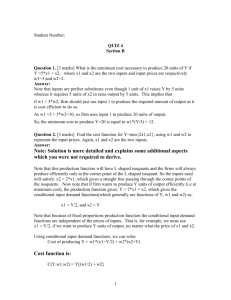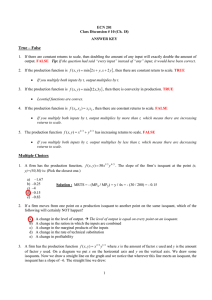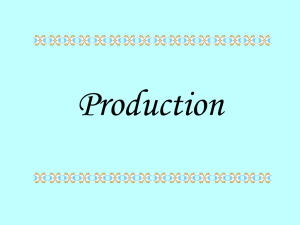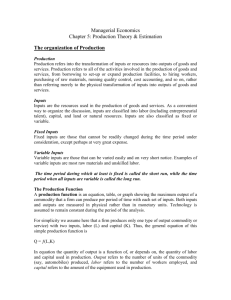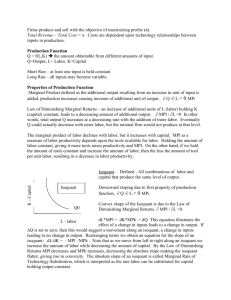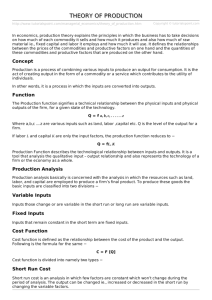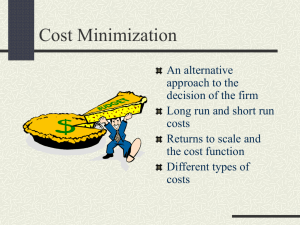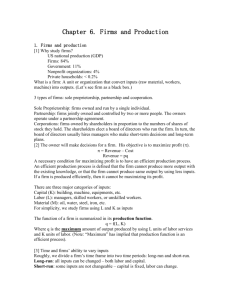Lecture 11: Minimisation of cost and demand for factors
advertisement
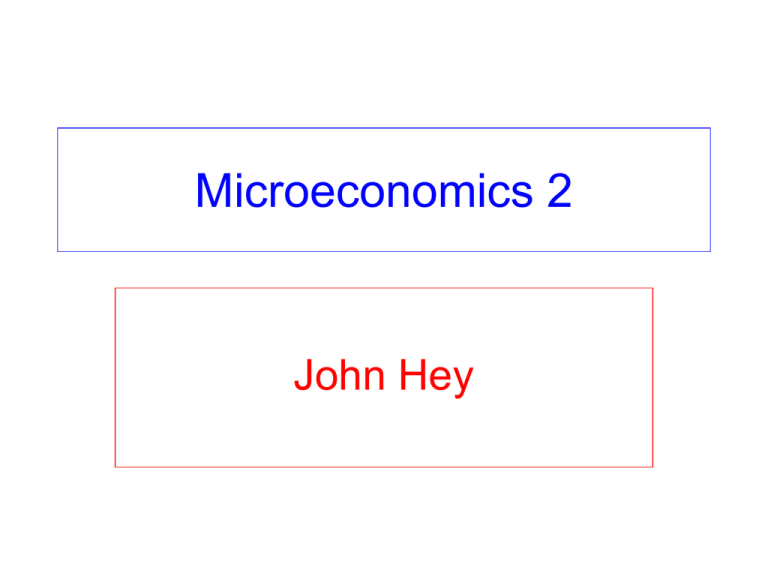
Microeconomics 2 John Hey Supply: the firm • Firms have to decide (at least) two things: • (1) How to produce and (2) How much to produce. (If a monopolist or an oligopolist also the price – chapters 28 and 31). • How to produce: Chapter 11 - Cost minimisation and the demand for factors. • Chapter 12: Cost curves (preliminary to chapter 13) • How much to produce: Chapter 13 – Supply. • Note that there is some ‘homework’ at the end of this presentation. Rating the lectures • • • • • • • Lecture 10 (technology): no stars Lecture 11 (how to produce): * Lecture 12 (cost curves): ** Lecture 13 (supply): *** Lecture 14 (ppfs): **** Lecture 15 (prodn & exchange): ***** Lecture 16 (empirics): ****** but tough Chapter 11 • In Chapter 10 we introduced the idea of an isoquant – the locus of the points (in the space (q1,q2) of the quantities of the inputs) for which the output is constant. • Also the production function: • y = f (q1,q2) where y denotes the output. • An isoquant is given by: • y = f (q1,q2) = constant. Particular cases of technology • Perfect substitutes 1 to a: isoquants are straight lines with slope a. • Perfect complements 1 with a: isoquants are L-shaped and the line joining the corners has slope a. • Cobb-Douglas with parameter a: isoquants are smoothly convex everywhere. • CES with parameters c1, c2, ρ and s: isoquants are smoothly convex everywhere. Two dimensions • The shape of the isoquants: depends on the substitution between the two inputs. (We call the magnitude of the slope of an isoquant the marginal rate of substitution between the inputs). • The way in which the output changes from one isoquant to another – depends on the returns to scale. Returns to scale with CobbDouglas technology : examples • • • • • • • Case 1: f(q1,q2) = q10.4 q20.6 Constant returns to scale. Case 2: f(q1,q2) = q10.3 q20.45 Decreasing returns to scale. Case 3: f(q1,q2) = q10.6 q20.9 Increasing returns to scale. Note: the ratio of the exponents is the same – hence the shape of the isoquants is the same – but they have different returns to scale. Chapters 11, 12 and 13 • We assume that a firm wants to maximise its profits. • We start with a small firm that has to take the price of its output and those of its inputs as given and fixed. • Given these prices, the firm must choose the optimal quantity of its output and the optimum quantities of its inputs. Chapters 11, 12 and 13 • We do the analysis in stages… • …in Chapter 11 we find the optimal quantities of the inputs – given a level of output. • …in Chapter 12 we develop the idea of a cost function, which enables us... • ...in Chapter 13 to find the optimal quantity of output. • (Recall that we are assuming that all prices are given.) Chapter 11 • So today we are finding the cheapest way of producing a given level of output at given factor (input) prices. • This implies demands for the two factors... • ... which are obviously dependent on the ‘givens’ – namely the level of output and the factor prices. • If we vary these ‘givens’ we are doing comparative static exercises. • The way that input demands vary depends upon the technology. Notation • • • • • We use the following notation: y for the level of the output. p for the price of the output. w1 and w2 for the prices of the inputs. q1 and q2 for the quantities of the inputs. • We define an isocost by • w1q1 + w2q2 = constant • …this is a line with slope –w1/w2 • Let’s go to Maple… How to produce • The optimal combination of the inputs is given by the condition: • The slope of the isoquant at the optimal point must be equal to to the relative prices of the two inputs. (MRS=w1/w2) • This assumes that the isoquants are strictly convex. • Rather obviously, the output must be equal to the desired output. Conclusions • The demand curve for an input is a function of the prices of the inputs and the desired output. • The shape of the demand function depends upon the technology. • From the demand functions we can infer the technology of the firm. • Before you go, some homework... Homework • CES technology with parameters c1=0.4, c2=0.5, ρ=0.9 and s=1.0. • The production function: • y = ((0.4q1-0.9)+(0.5q2-0.9))-1/0.9 • In the next slide I have inserted the isoquant for output = 40 (and also that for output=60). • I have inserted the lowest isocost at the prices w1 = 1 and w2 = 1 for the inputs. • The optimal combination: q1 = 33.38 q2 = 37.54 • and the cost = 33.58+37.54 = 70.92. What you should do • Find the optimal combination (either graphically or otherwise) and the (minimum) cost to produce the output for the following: • w1 = 2 w2 = 1 y=40 • w1 = 3 w2 = 1 y=40 • w1 = 1 w2 = 1 y=60 • w1 = 2 w2 = 1 y=60 • w1 = 3 w2 = 1 y=60 • Put the results in a table. Chapter 11 • Goodbye!
